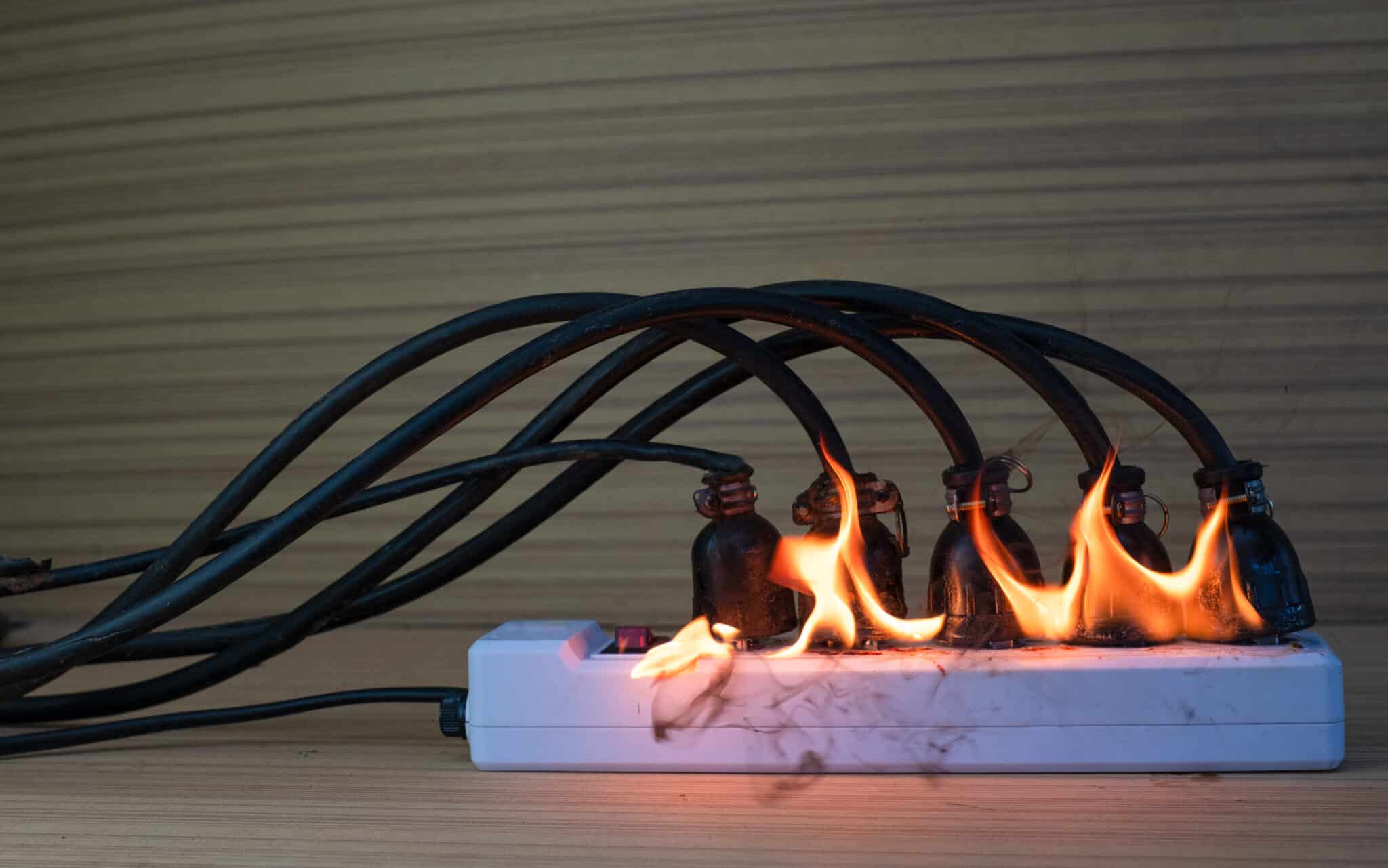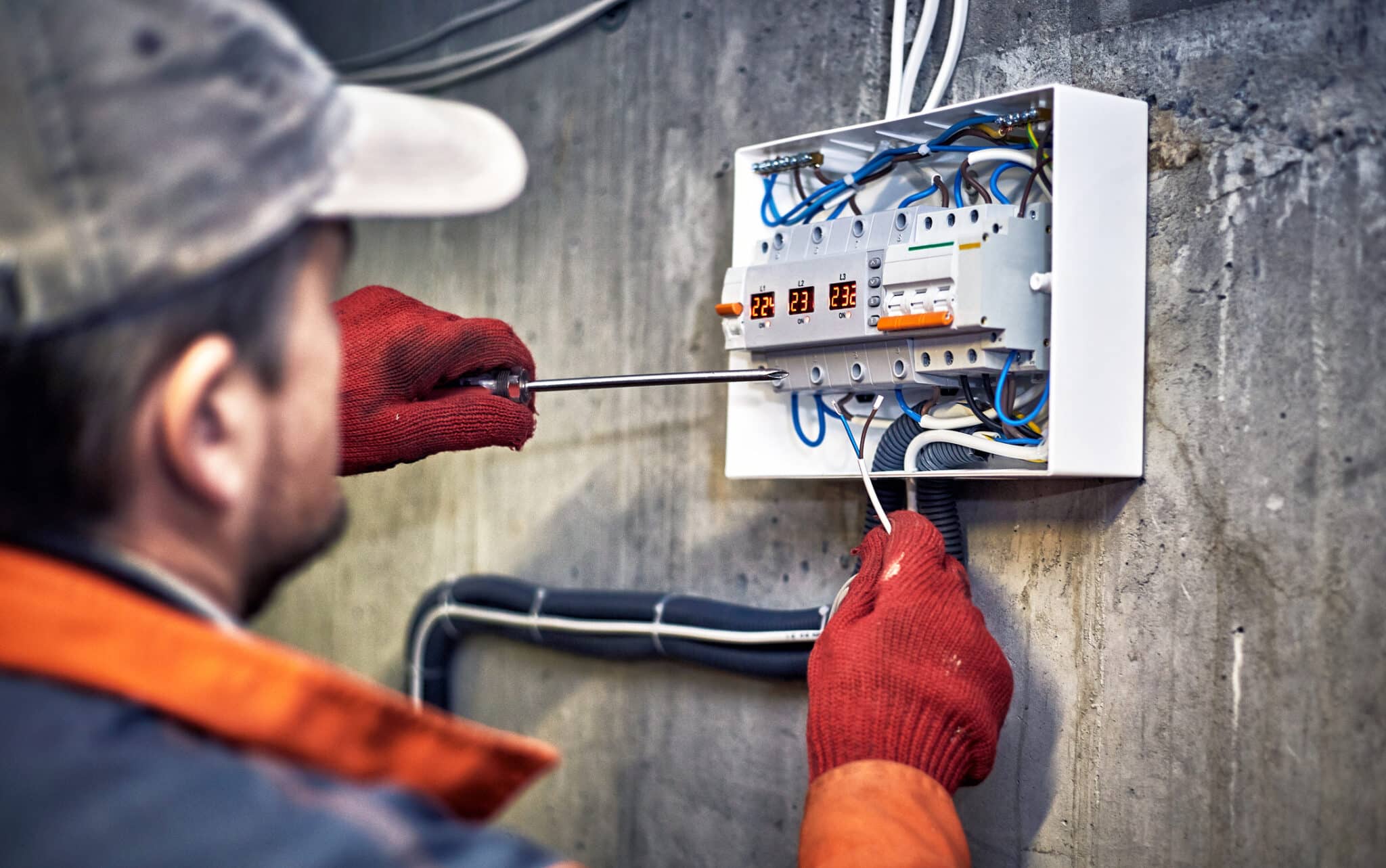Overloading Circuits – The holiday season is here, and nothing says festive quite like a house twinkling with lights and decorations. But before you plug in all those extra holiday lights and lawn displays, have you considered the strain they might put on your home’s circuits?
Overloading circuits isn’t just a small inconvenience—it can lead to serious issues like power outages or even electrical fires. With a few simple tips, you can decorate safely, avoid mishaps, and keep the holiday cheer bright and trouble-free.
Understanding Circuit Overload
Holiday decorations add that magical touch, but plugging too many in can spell trouble for your home’s electrical system. Understanding circuit overload is the first step in keeping your holiday lighting safe and problem-free.
What is Circuit Overload?
Circuit overload happens when you connect too many electrical items to a single circuit, pushing it beyond its capacity. Every circuit in your home is designed to handle only a specific amount of electricity, determined by the circuit’s wiring and breaker size.
When holiday lights, inflatables, and other decorations demand more power than a circuit can provide, it strains the system and may lead to tripped breakers or even power outages.
In more extreme cases, overloaded circuits can cause wiring to overheat, increasing the risk of electrical fires. Recognizing and preventing circuit overload is essential to keeping your holiday setup safe and your home protected.
Signs of a Circuit Overload
Wondering if your circuits might be overloaded? Spotting the signs early can prevent more serious issues. Here are a few clear indicators to watch for:
- Flickering lights: If your holiday lights start to dim or flicker unexpectedly, it’s often a sign your circuit is struggling to keep up with the power demand. This usually happens when too many decorations are drawing energy from the same source.
- Breaker trips: When your circuit breaker frequently flips off while your holiday lights are on, it’s likely a sign of overload. Breakers are designed to shut down the circuit if they sense an electrical overload, acting as a safety measure to prevent overheating and potential fire hazards.
- A burning smell or warm outlets: One of the most concerning signs of an overloaded circuit is a burning smell or an outlet that feels unusually warm to the touch. Overheating wires can lead to electrical fires, so it’s critical to unplug decorations and address this immediately if you notice these signs.
Spotting these early warning signs can make all the difference, especially during the holidays when homes in Charleston, Mt. Pleasant, and James Island are decorated with extra lights and festive displays. Ensuring your decorations stay bright and safe will keep your season worry-free!

Why Overloading Circuits is Dangerous
Decorating for the holidays is always fun, but overloading circuits can be downright dangerous. The extra demand we place on our electrical systems with holiday lights, inflatable displays, and more can cause problems that go far beyond flickering lights or tripped breakers. Let’s look at why overloading circuits can be a serious hazard.
Risk of Electrical Fires
One of the biggest dangers of overloading circuits is the increased risk of electrical fires. When you put too much strain on a circuit, it pushes a large amount of power through your home’s wiring, causing it to overheat.
Overheated wires can spark and ignite nearby flammable materials, which is particularly concerning during the holidays when decorations often involve synthetic fabrics, paper, and plastic that catch fire easily.
If decorations are wrapped around a dry Christmas tree or near wooden surfaces, the risk multiplies, creating a serious fire hazard. So, while a fully decorated home looks festive, keeping the risk of overloading circuits in mind is essential for maintaining a safe holiday environment.
Damage to Electrical Devices and Circuits
Beyond the fire risk, overloading circuits can also damage your devices, appliances, and home wiring. When circuits are overused for prolonged periods, they wear down faster, causing outlets and wiring to deteriorate.
Overloaded circuits don’t just affect holiday lights; other devices connected to the same circuit, like televisions, refrigerators, and kitchen appliances, can suffer as well. This added strain can result in costly repairs and replacements over time.
By managing your power needs wisely, you help protect not only your holiday decorations but all the valuable electronics and appliances in your home, avoiding the risks that come with overloading circuits.
Steps to Avoid Overloading Circuits During the Holidays
Taking a few steps to prevent circuit overload can make all the difference in keeping your holiday decorations safe and enjoyable. A little planning and smart choices can help spread out your decorations’ power needs and prevent strain on your circuits.
Plan Your Decoration Layout
When planning your holiday decorations, it’s essential to avoid overloading circuits by distributing decorations across different circuits in your home. Begin by identifying outlets connected to separate circuits and placing larger, high-energy decorations, like inflatable displays, in these areas.
This approach balances the electrical load throughout your home, reducing the chance of overloading any single circuit. Dividing power usage among circuits not only keeps your decorations lit consistently but also prevents circuits from overheating and tripping. Planning your layout thoughtfully can make a big difference in keeping your decorations safe and festive all season long.
Use Energy-Efficient Holiday Decorations
Using energy-efficient decorations, such as LED lights, is a great way to decorate while minimizing the risk of overloading circuits. LED lights use a fraction of the electricity that traditional incandescent bulbs consume, allowing you to safely add more decorations without straining your electrical system.
These lights are not only safer and more durable, but they also come in various colors and styles that let you celebrate the holidays with flair.
Additionally, LED lights tend to last longer, saving you both energy and money over time. Opting for energy-efficient holiday decorations is an easy step to keep your circuits safe and the holiday spirit bright.
Limit the Use of Extension Cords and Power Strips
Extension cords and power strips can seem handy for setting up your holiday lights, but too many can contribute to overloading circuits if used improperly. It’s best to limit the number of items plugged into a single power strip and avoid daisy-chaining multiple extension cords, as this increases the risk of overheating.
If you need to use extension cords, choose ones with built-in surge protection to safeguard against electrical surges. Plugging too many decorations into one outlet or power strip can also wear out your home’s wiring, posing additional risks.
Minimizing extension cords and power strips helps ensure your holiday decorations operate safely and avoid circuit overloads.
Calculate Your Power Needs
Calculating your power needs ahead of time can be a simple but effective way to prevent overloading circuits during the holiday season. Start by checking the wattage on each of your decorations and adding up the total to see if it exceeds your circuit’s capacity, which is usually noted on your breaker box.
Keeping the combined wattage below the circuit limit is crucial to avoid tripping breakers or causing electrical issues. If your wattage total is close to the circuit’s maximum, consider removing some decorations or distributing them to another circuit. Doing this basic math ensures that your holiday setup runs smoothly without unexpected power interruptions.
Smart Tips for Safe Holiday Lighting
Taking a few extra steps with your holiday lighting setup can keep your home safe and make your decorations shine without any risks to your electrical system.
Use Surge Protectors
Using surge protectors for your holiday decorations is a smart strategy to avoid overloading circuits and protect against unexpected power surges. Surge protectors work as a shield for your electrical system, absorbing sudden power spikes that could otherwise harm your decorations or home wiring.
Plugging lights and other decor into a surge protector instead of directly into the wall adds a critical layer of safety, helping prevent circuit overloads caused by extra holiday lighting.
This is especially useful for protecting more delicate or costly decorations, like inflatable displays, from power disruptions. Investing in a surge protector not only enhances safety but also brings peace of mind during the festive season.
Set a Timer for Your Lights
Setting a timer for your holiday lights is an easy way to manage your display and prevent overloading circuits. A timer ensures that your lights are only on when you want them to be, reducing continuous power drain that can stress your electrical system.
Timers let you control how long your decorations stay on, which means you’re less likely to leave them running overnight and putting unnecessary strain on your circuits.
This not only saves energy but also keeps your wiring from overheating, which can happen if circuits are under heavy demand for extended periods. By using a timer, you’re making holiday lighting both safer and easier to manage.
Inspect and Replace Old or Damaged Decorations
Inspecting and replacing old or damaged decorations before use is essential to avoid overloading circuits and to ensure safe holiday lighting. Look for worn-out wires, frayed cords, or cracked bulbs—all signs that decoration may be unsafe and could lead to circuit issues.
Damaged lights are prone to electrical shorts, which can result in blown fuses or, in severe cases, electrical fires. Checking decorations thoroughly each season helps you catch and replace unsafe items, reducing potential strain on your circuits.
Keeping your decorations in good condition not only enhances safety but also minimizes the risk of overload, letting you enjoy a festive, worry-free holiday atmosphere.
Safe Alternatives to Plugged-In Decorations
Using alternative decorations that don’t require being plugged into your home’s electrical system can be a great way to reduce the load on your circuits and still enjoy a festive atmosphere.
Battery-Powered Options
Battery-powered decorations offer a convenient way to decorate without tapping into your home’s electrical circuits. They come in various styles, from string lights to small lighted ornaments, allowing you to place them wherever you like without worrying about finding an outlet.
Battery-powered lights also tend to be energy-efficient, often lasting several days or weeks on a single set of batteries. Plus, they eliminate the risk of overheating wires or overloading a circuit. Choosing battery-operated decorations lets you enjoy a beautifully lit space while keeping circuits clear for other essentials.
Solar-Powered Holiday Decorations
Solar-powered holiday decorations are another excellent alternative for reducing electrical demand, especially in areas that get a fair amount of sunlight during the day. These decorations absorb sunlight to recharge during daylight hours, storing energy for nighttime use without relying on your home’s electricity.
From solar pathway lights to solar-powered string lights, there are plenty of options that create a festive look while remaining environmentally friendly. Solar decorations are an energy-saving choice that provides peace of mind, knowing they won’t contribute to circuit overload.
Flame-Free Candles and Lighted Decorations
Flame-free candles and lighted decorations bring a cozy, warm glow to your home without any need for outlets or real flames. Battery-operated LED candles, for example, mimic the look of real candles while being far safer and easier to use, especially around children and pets.
You can also find flameless lanterns or decorative LED lights for wreaths and centerpieces. These options add holiday ambiance with no electrical risks and no worries about circuit overload, giving you a safe, beautiful way to enhance your home’s holiday spirit.
Creating a Circuit-Safe Holiday Routine
Establishing a routine for managing your holiday decorations can help keep your circuits safe while ensuring your home stays festively bright all season long.
Monitor and Adjust
Regularly monitoring your decorations and the circuits they’re connected to throughout the holiday season is essential for preventing overloading circuits. By making a habit of checking your setup, you can catch any early signs of strain, like flickering lights or outlets that start to feel warm.
These signs indicate that your circuit may be overloaded and struggling to handle the power demand of your holiday decorations. If you spot these warning signs, try unplugging a few decorations or moving some to a different circuit to distribute the load more evenly.
Taking these small but consistent monitoring steps can help you avoid the risks of overloading circuits while keeping your holiday decorations shining bright and safe.
Avoid Using All Outlets on the Same Circuit
To avoid overloading circuits, try not to plug all your holiday decorations into outlets on the same circuit. Using multiple circuits throughout your home helps spread the power demand, reducing the risk of overheating and keeping your system safe.
For example, outdoor lights can be placed on one circuit, while indoor lights connect to another, or even switch to outlets in different rooms if they’re on separate circuits.
This balance allows each circuit to handle a lighter load, minimizing the chances of tripped breakers or wiring damage. By spreading decorations across circuits, you protect your electrical system from strain and enjoy a beautifully lit, worry-free home.
Light Up Safely This Holiday Season with Mister Sparky of Charleston!
Ready to decorate without the worry of overloading circuits? Mister Sparky of Charleston is here to help residents in Charleston, Mt. Pleasant, and James Island keep their homes safe and bright all season long.
Our expert electricians can assess your electrical system, provide guidance on safe holiday lighting, and ensure your circuits are ready for the festivities.
Don’t let electrical issues dim your holiday cheer—contact Mister Sparky of Charleston to make sure your home is both beautiful and safe this holiday season!

FAQs About Overloading Circuits
How can I tell if my holiday lights are too much for my circuit?
Signs of overloading circuits include flickering lights, frequent breaker trips, or outlets that feel warm. If you notice any of these, reduce the number of lights or spread them across different circuits. Taking these steps can help prevent circuit overload and keep your home safe.
Are LED lights really safer for holiday decorating?
Yes, LED lights use much less energy, reducing the risk of overloading circuits compared to traditional incandescent bulbs. LEDs also produce less heat, which means they’re less likely to cause overheating. Switching to LED lights is a safe choice for decorating.
Can I use extension cords for all my holiday lights?
Using too many extension cords can contribute to overloading circuits, especially if they are daisy-chained. Limit extension cord use and choose cords with surge protectors to keep your circuits from overheating. This helps prevent power issues and keeps decorations safer.
How often should I inspect my holiday decorations?
Inspecting decorations annually for frayed wires and damage is essential to avoid overloading circuits. Damaged decorations can increase circuit demand, leading to overload. Checking decorations each year keeps your holiday setup safe and reliable.
Is it okay to leave my holiday lights on all night?
Leaving holiday lights on all night can increase the risk of overloading circuits, electrical malfunctions, and potential fire hazards. Using a timer helps manage usage, keeping circuits from being overloaded for extended periods, reducing risks and extending the lifespan of your lights. This simple step adds safety, conserves energy and offers peace of mind.






